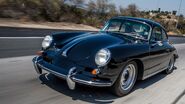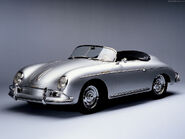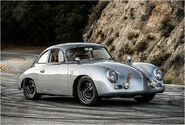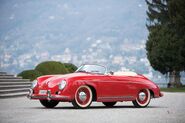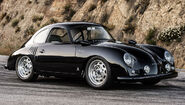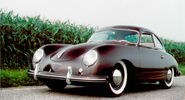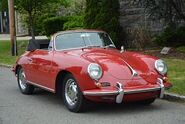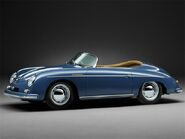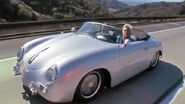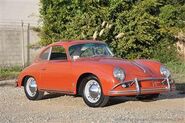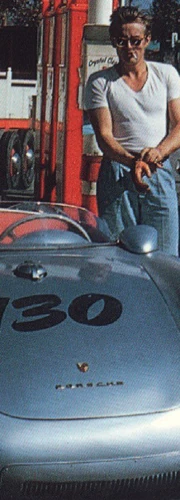
| |
| Porsche 356 | |
|---|---|
| Porsche | |
| aka | 356 356 Pre-A 356A 356B 356C |
| Production | 1948 - 1965 (76,303 units produced) |
| Class | Sports car |
| Body Style | 2-door, 2-seat Coupe 2-door, 2-seat Cabriolet 2-door, 2-seat Speedster 2-door, 4-seat Coupe |
| Length | 152.4 - 157.9 in (3870 - 4010 mm) |
| Width | 65.4 in (1660 mm) |
| Height | 48.0 - 51.8 in (1220 - 1310 mm) |
| Wheelbase | 82.7 in(2100 mm) |
| Weight | 1700 - 2296 lbs (770 - 1040 kg) |
| Transmission | |
| Engine | 1.1 litre Boxer 4 1.3 litre Boxer 4 1.5 litre Boxer 4 1.5 litre DOHC-Boxer 4 1.6 litre Boxer 4 1.6 litre DOHC-Boxer4 2.0 litre DOHC-Boxer4 |
| Power | 40 hp (DIN) 44 - 60 hp (DIN) 55-70 hp (DIN) 100 - 110 hp (DIN) 60 - 95 hp (DIN) 105 - 115 hp (DIN) 130 hp (DIN) |
| Similar | Volkswagen Beetle Volkswagen Karmann Ghia |
| Designer | Erwin Komenda |
The defeat in the Second World War had hit Germany hard. The booming pre-war industry was in tatters, and the country teetered upon the edge of bankruptcy. Ferdinand Porsche was in prison, and the Stuttgart headquarters was inhabited by American forces - the skilled workers consigned to repairing farm machinery and American vehicles.
Porsche faced a stiff task ahead of them, to pull themselves back up to being able to produce world-beating sports cars. The Porsche 356 is a testament to how dedicated the people behind the company were in turning their bleak circumstances around. It was designed and signed off two months before Dr. Porsche was released from prison, and would become the first vehicle with the Porsche crest displayed proudly on its bonnet. The 356 would remain in production for almost twenty years, with production topping near-on 80,000 examples.
From Bleak Beginnings[]
During the Second World War, the Porsche company relocated to neutral Austria for safety. The new factory was set up in rural Gmund, in a series of wooden huts, far from transport links. Raw materials were constantly being pilfered for the German war effort, and production at the facility was painfully slow and disjointed. Despite this, most of the 356's development occurred in Gmund, with the first prototype seeing the light of day in 1948. Under a pretty aluminium skin lay predominately Volkswagen Beetle mechanicals, but despite this the Number One, with the aid of twin carburettor setup, was able to reach a power output of 40 BHP and a top speed of 80 mph. The car won class victory competing in an Innsbruck road race.
Porsche initially wished for a mid-engined set up, as per his Auto Union racing car. However, this could not be supported by the Beetle chassis without extensive and expensive modification, and thus the standard rear-engined setup was retained - and became a feature on the successor, the 911. The spaceframe chassis of the Number One was changed for a box-section chassis for the production cars, providing such a stiff structure that would allow the cars to drive without their bodywork.
It is unknown how many Gmund 356s were built, as factory records were very sketchy. However, estimates maintain that around 50 were produced, each to individual customer specifications.
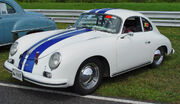
Porsche 356
The Pre-A - 1950-1955[]
The Porsche company soon outgrew the Gmund production huts, and went back to Stuttgart to continue producing the 356. The Pre-A was virtually identical to the Gmund 356, but the main difference lay in the bodywork - the aluminium was replaced with steel. As a consequence, the silhouette of the Pre-A featured a higher bonnet and waistline. Also, larger bumpers with over-riders were fitted, along with a one-piece windscreen, as opposed to the cheap, double-pane example of the Gmund. The bodies for the coupe were produced by Reutter, while the cabriolets were produced by Glaaser, and each coachbuilder was awarded with a small crest at the bottom of the front wings.
In 1952, the Pre-A was upgraded, with slightly wider pressed steel wheels, along with minor interior upgrades and the option of cloth and corduroy as seat fabric. The mechanical modifications culminated in the movement of the gearlever forward by 12 cm, a move much welcomed by the buyers - the earlier 356s required almost contortionist skills to change gears.
As in the Gmund, the Pre-A initially used the Beetle's 'Crash' gearbox, but was later upgraded to use a Getrag engineered synchronised unit, assembled by Porsche. The Pre-A was offered all through its lifetime with the original Beetle 1.1 litre four-cylinder. However, 1952 heralded the introduction of a 1.3 litre engine, essentially a modified version of the original. Thus the differentiation between the engines became known - with the 1.1 becoming nicknamed the 'Dame' (German for 'lady'). Later in the year, the range was widened further with the unveiling of the 'Super', boasting a 70 BHP 1.5 litre engine. An example powered the car to third place in the Rome-Liege-Rome rally of the same year.
Porsche predicted a demand of 500 sales for the Pre-A, however, this was wildly pessimistic - in reality, sales past this marker in early 1951, eventually topping almost 10,000 units by the end of its lifetime. However, Porsche was sure it could improve, and after listening intently to customers' feedback released the 356 A in 1956.
The 356 A - 1956-1959[]
Porsche had been overwhelmed by the success of the Pre-A model, but the burgeoning company did not rest upon their laurels. The 1955 Frankfurt Motorshow marked the unveiling of the new 356 model, badged the A.
The 356 A would be offered with a whole new model range. At the bottom of the ladder was the 1300 and 1300S models, developing 44BHP and 60BHP respectively from their four-cylinder powerplants. These cars were identifiable from their quicker brethen by their black painted engine fan, and due to the easy-to-control and malleable nature of these models, they were christened 'Damen', German for 'Lady'.
Above the 1300 models was the 1600, available in standard or S trim - the S, denoting 'Super', featured a Hirth roller-bearing crank attached to the standard engine, which liberated more power. Despite their larger capacity, the 1600 produced the same power output as the 1300S. However, more of that power and torque was available lower down the rev-range, allowing the car to be driven swiftly at all times. Topping off the range was the 356 Carrera, fitted with a rorty 1500 cc engine. This model produced the most power of the range, and was intended as a 356 which could be used in street races.
The first major upgrade for the 356 A occurred in 1957, when the 1300 and 1300 S were both dropped, due to lack of demand. Minor details to the steering system, along with the appearance of a new gearbox design, took place in the same year. The tweaking of the model range continued in early 1959, when the 1600cc engine was extensively modified. The Solex carburettors were replaced with Zenith examples, and the Hirth roller-bearing crank was removed, due to the system proving complicated and sometimes chronically unreliable. The size of the oil cooler increased, along with the addition of iron cylinder barrels, employed to reduce the noise of the engine.
As well as out-performing the Pre-A, the 356 A looked much more modern. Although huge styling changes were not performed, the switching of the twin-piece windscreen to a smoother, single piece one, along with an increase in wheel size to 15 inches all added up to give the car a fresh look. The sill-line was also modified, and a new rear light design was devised. Internally, the A broke a lot of new ground. The interior became more luxurious, with padded sunvisors, cloth headlining and upholstered dashboard combining with pedal re-routing and enhanced visibility to create a cabin of greater quality and of better ergonomics to drivers.
The 356 A was another sales success for Porsche, selling over 20,000 examples within its lifetime. But customers continued to demand more power and performance, and in 1959, the last 356 A rolled off the Stuttgart production line.
The 356 B - 1959-1963[]
The 356 B took over the reigns of the 356 A in 1959, and proved to be a gentle evolution of the rock-solid 356 concept. Externally, as on the 356 A, minor changes added up to a completely new look - for example, the bumpers were increased in size and strength, and also positioned higher up the car. The headlights were uprighted by a couple of degrees, and new wings were fashioned to accomodate this. A larger, heavier, chromium-plated handle was utilised on the bonnet, changing the face of the car.
Internally, the cabin benefitted from larger windscreens, and the option of sunroofs. Luggage space, or at least the ease of access to the space, was increased by the modification of the bonnet, and the engine received a twin-louvered cover.
Although upgraded, the car was considered ugly at first. yet after continued use in films and races, the B won lots of respect
As well as the continued use of the 1600 and 1600S models, in 1960 Porsche bolstered the range with the addition of the Super 90, the most powerful 356 yet. Pushing out 90BHP, thanks to a higher compression ratio, a modified cylinder head, new Solex carburettors, bigger valves and lighter cylinders, the Super 90 was capable of up to 110 mph - super performance for the period. The Super 90 also marked the introduction of radial tyres on Porsche cars.
The 356 B, in all its forms, went on to sell over 30,000 cars.
The 356 C - 1963-1965[]
To ease the transaction into its newest model, the 911, Porsche continued to upgrade the 356 to keep the large loyal customer base content. The venerable 1600cc engine was continued, albeit with a reprofiled camshaft and bigger valves, which managed to eke out slightly more power. The model range consisted of a 356 C and a 356 SC, as in the vein of the previous models.
The ride was softened, primarily for the American market, which had now become Porsche's largest merket, by far. To keep the inevitable masses of bodyroll incurred by this step in check, thicker anti-roll bars were used. Disc brakes were featured all-round.
Despite a loyal customer base, which was reflected in consistent sales numbers, Porsche decided to move on from the 356. In 1965, production of the 356 ceased, and was replaced by the 911, which was both considerably more expensive and more difficult to drive.
The Cabriolet and Soft-top Variants[]
Cabriolet versions of the 356 had been offered since the model's introduction - and it is estimated that around half of the Gmund 356s were cabriolets. Mechanically, all cabriolet versions were identical to their fixed-roof brethren, but weighed slightly more due to increased structural strengthening.
The most famous 356 drop-top was the Speedster, introduced in 1954, with the American market in mind. The concept was the brainchild of the USA's Porsche importer, Max Hoffman, who convinced Porsche that the sale of a drop-top, lightweight and barely weather-proof 356 was just what the dry states of America needed. The Speedster was a hit from the off, especially in California. The high sales of the model, peaking at around 1,200 in 1957, began to decline, and the model was replaced by the 356 D Convertible, which featured slightly more weather protection, a higher fixed windscreen and a more substantial hood. The 356 D Convertible was produced for only one year, and its lack of success showed just how little demand for the once-popular cabriolet models was.
The 356 D Convertible was replaced by the 356 B Roadster.
Gallery[]
See Also[]
